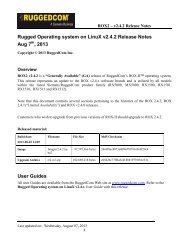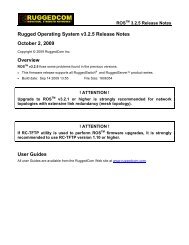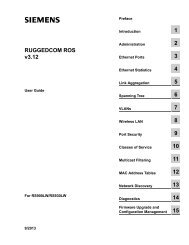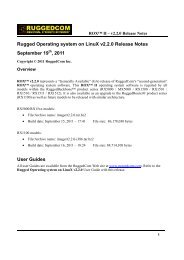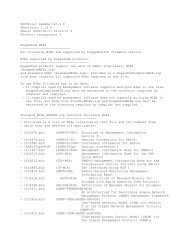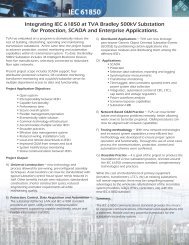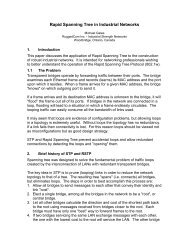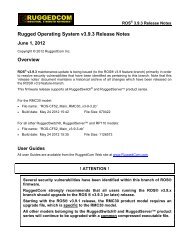Performance of the rapid spanning tree protocol in ... - RuggedCom
Performance of the rapid spanning tree protocol in ... - RuggedCom
Performance of the rapid spanning tree protocol in ... - RuggedCom
Create successful ePaper yourself
Turn your PDF publications into a flip-book with our unique Google optimized e-Paper software.
Bridge Diameter: The maximum number <strong>of</strong> switches between any two end stations.Root Port: The port that <strong>of</strong>fers <strong>the</strong> lowest cost path to <strong>the</strong> root bridge.Designated Port: The port that propagates Root <strong>in</strong>formation to <strong>the</strong> attached network segment.Alternate Port: The port that <strong>of</strong>fers <strong>the</strong> next best cost path to <strong>the</strong> root bridge and will become Root Port,if <strong>the</strong> current Root Port loses connectivity with <strong>the</strong> root bridge.Discard<strong>in</strong>g port state: The state <strong>in</strong> which <strong>the</strong> port is only send<strong>in</strong>g and receiv<strong>in</strong>g STP BPDUs whileblock<strong>in</strong>g any regular network traffic.Forward<strong>in</strong>g port state: The state <strong>in</strong> which <strong>the</strong> port is send<strong>in</strong>g and receiv<strong>in</strong>g both STP BPDUs and regularnetwork traffic.2.2.2 RSTP – IEEE 802.1w [2]The STP <strong>protocol</strong> was first published <strong>in</strong> <strong>the</strong> IEEE 802.1D-1990 standard and has proven to be a reliablemethod for provid<strong>in</strong>g path redundancy while elim<strong>in</strong>at<strong>in</strong>g loops. However, STP was not orig<strong>in</strong>allydesigned for speed; when a l<strong>in</strong>k fails or a failed l<strong>in</strong>k returns to service, STP requires at least 30 seconds torestore network connectivity. RSTP is an evolution <strong>of</strong> STP. It was <strong>in</strong>troduced <strong>in</strong> <strong>the</strong> standard extensionIEEE 802.1w, and provides for faster <strong>spann<strong>in</strong>g</strong> <strong>tree</strong> convergence after a topology change. The 802.1Dterm<strong>in</strong>ology rema<strong>in</strong>ed primarily <strong>the</strong> same, and most parameters have been left unchanged. However,RSTP uses several new concepts:Tak<strong>in</strong>g advantage <strong>of</strong> a physical l<strong>in</strong>k failure/recovery detection: While STP was passively wait<strong>in</strong>g for atimer to expire to react to a change <strong>in</strong> a l<strong>in</strong>k state, RSTP may act immediately upon a l<strong>in</strong>k failure/recoverydetection.Proposal-Agreement mechanism: This is a feedback mechanism that takes place between RSTPcompliantbridges. While STP was passively wait<strong>in</strong>g for <strong>the</strong> network to converge before turn<strong>in</strong>g a port<strong>in</strong>to <strong>the</strong> forward<strong>in</strong>g state, RSTP is able to actively confirm that a port can safely transition to forward<strong>in</strong>gwithout rely<strong>in</strong>g on any timer configuration. This leads to a faster convergence.Edge ports: All ports that have been configured as edge ports are placed <strong>in</strong> forward<strong>in</strong>g state withoutcheck<strong>in</strong>g for loops.The new enhanced mechanisms allow RSTP to reduce failover and recovery times to just a few seconds.3



